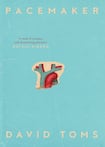
It is not until near the end of this slim book that the titular pacemaker makes its appearance. “I lie straight on my back, dressed from the waist down, and a kind of tarp placed between my face and chest so I can’t see exactly what is going on below my neck.” The author is wide awake throughout the operation. He chats to one of the Norwegian surgeons about playing golf in Ireland.
It is the surreal culmination of a journey that started at the moment of his birth, in Airmount Maternity Hospital in Waterford in 1988, with the diagnosis of a rare congenital heart defect. Toms was born blue and baptised immediately. At three months’ old he had complex heart surgery and from then on his life was punctuated by annual hospital appointments and inhibited by certain physical limitations. This book — which is part prose poem, part memoir — loosely yet expansively tells the story of the years sandwiched between surgeries.
Pacemaker is divided into 12 chapters, and each chapter is made up of several sections which rarely stretch to more than a page, with some as short as a couple of lines. It fits nicely into a genre of non-fiction that I have seen referred to as “space literature” — in which short passages of prose are surrounded by lots of white space and unconstrained by plot. Maggie Nelson’s Bluets is a good example, and in his closing pages Toms notes my 2020 non-fiction debut handiwork as an influence alongside a list of others.
Pacemaker is “space literature” at its strongest. There are many perceptive asides referencing Greek myth, Celtic folklore, Italia ‘90, Bob Dylan. Toms recounts the history of the atrial switch operation, the biblical origins of the walking staff, the evolution of the European calendar. The author trusts the reader to meander with him, and these diversions are always illuminative. As a poet he knows how to handle the blanks and his use of language is agile throughout, with an ear for repetition and the music of medical terminology.
READ MORE
“Every time I write about my heart, I write about walking. Every time I write about walking I write about my heart.” As a child Toms wanted to play football with his brothers but his heart condition prohibited him from strenuous exercise. As an adult, walking became a major source of solace and in Pacemaker he remembers the many routes he has taken over the decades, from brief and functional city strolls to the awe-inspiring forest trails north of Oslo. I loved these descriptions of Norway, which is where Toms now lives — the scenery, the changing moods and seasons, the dramatic light — and the depiction of his easy relationship with his “elghund”, Madra, “a wonderful companion for what can be a lonely disease”.
There is an exchange of emails between his partner, Miriam, in Oslo and his mother, Maria, in Waterford. It was a stroke of genius to include these, retaining the spelling mistakes and dropped punctuation
Just over half way through the book, there is a shift. The short sections become more like diary entries as Toms grows increasingly anxious and fixated on death. In the approach to 2020 his health starts to falter and in the earliest days of the pandemic, he catches Covid and is rushed to hospital. At this stage the author disappears from the text and the narrative is driven by an exchange of emails between his partner, Miriam, in Oslo and his mother, Maria, in Waterford. It was a stroke of genius to include these, retaining the spelling mistakes and dropped punctuation. They are wonderfully raw and tender, forming the dramatic core of the book. In spite of the fact that we know Toms will survive, still it is gripping. “It must be very hard for you on your own at least I have Johnny to drive me mad,” his mother writes, capturing a universal truth about the pandemic in just a few words.
Then the author’s voice returns to describe the hallucinations he experienced while his temperature was dangerously high, the loneliness and dislocation of lying flat on his stomach in the Covid ward. The final chapters are essentially an account of his slow repair and return to normal life. Toms has to learn to walk again, dragging a telemetry machine up and down the hospital corridors. After a number of months he has recovered enough to have the pacemaker — his “robot heart” — fitted and the circle of the book comes to a close. “It had been delayed for as long as possible, but the time had come for further surgery. A new pace was being set.”
Pacemaker is similar in spirit to Sinead Gleeson’s Constellations — another of the titles Toms lists as an influence — in that it is a searing and unconventional testimony of what it means to live with an invisible illness, and how this shapes a person. Pacemaker is a terrifically important book; brave, perceptive and — both literally and figuratively — full of heart.













